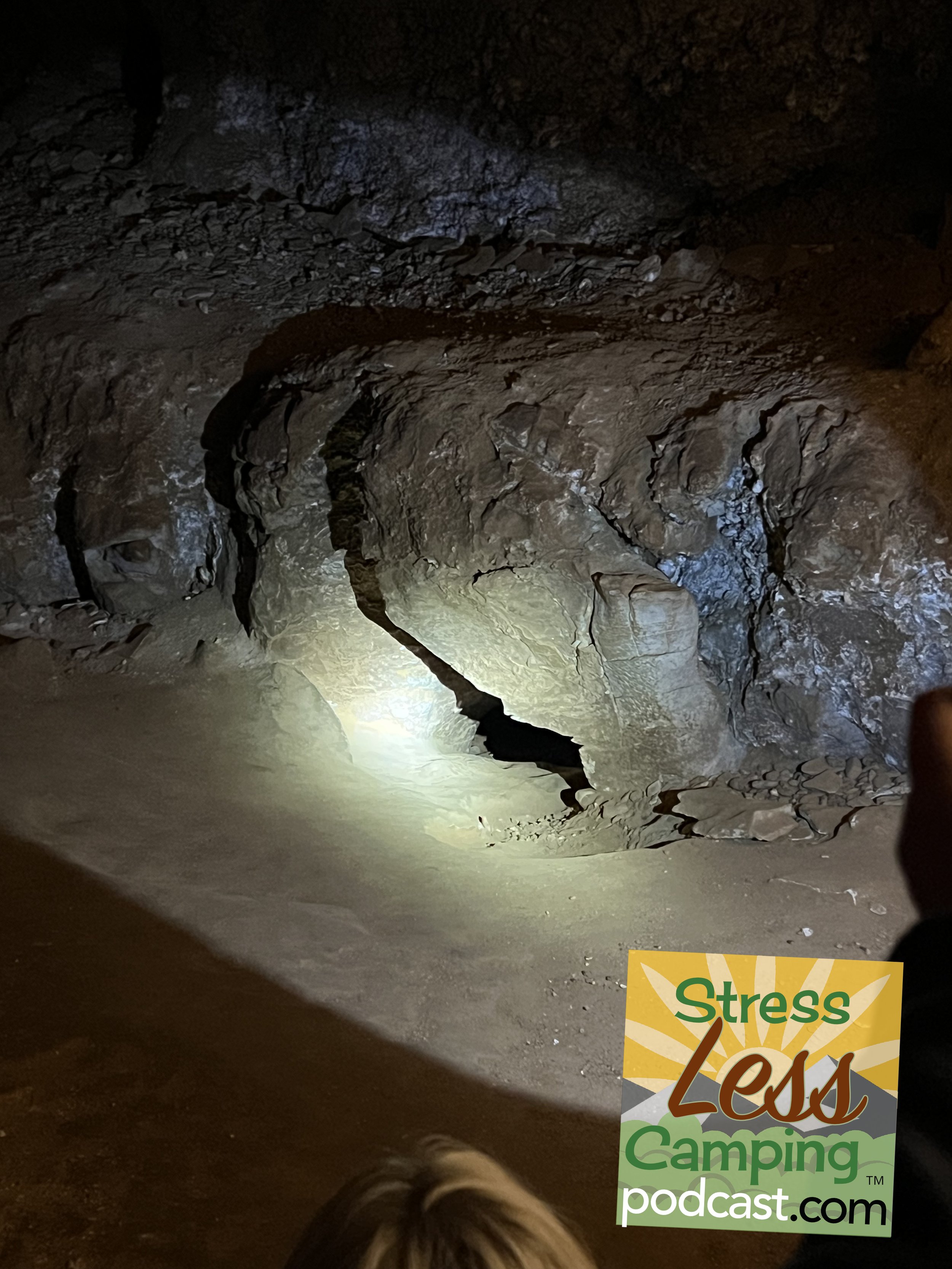The geology and history of Mammoth Cave
Mammoth Caves, located in south-central Kentucky, is a unique and fascinating geological wonder that has a rich and complex history. We got a chance to visit Mammoth Caves National Park and take a cave tour when we were in Kentucky.
A passageway in Mammoth Cave that leads to another section of the cave. Some braver souls have explored through these tiny openings and there are tours available where you can try this yourself.
Caverns and caves are fascinating to me. Also, taking a guided cave tour gives us an opportunity to safely spend time far underground, where it’s always cool and - when the guide turns off the lights - completely (and I mean completely) dark. It’s a favorite part of the tour for me, imagining some of the first brave souls who explored these passages with possible only a candle for light.
Caves or Caverns?
Let’s start with some terminology.
Why are some of these places called caves, and others called caverns? Well, simply put: it’s water. A more in-depth explanation is that a cavern is a cave in which - are you ready for this word? - speleothems are formed. A speleothem is the growth inside a cavern that grows because of addition of something. Gee thanks for being so specific! Hehe. OK, so that “something” is usually minerals that are dissolved in water. But really, water is the important ingredient. Without the water to dissolve the minerals, then ever so slowly drip, drip, drip into the cavern and evaporate, there wouldn’t be any growth. That’s when a cavern becomes a cave.
A model of much of the known portions of Mammoth Cave
Geology of Mammoth Caves
Hold on now. That can’t be right. How on earth could caves have formed without water? Well, it’s all in the timing.
In Mammoth Caves, most of the many, many miles of caves are currently dry. They weren’t always dry, as evidenced by existing speleothems in the caves. However, those growths are no longer growing. The water has long since disappeared and the dry cave is no longer “growing,” so those portions are called caves rather than caverns.
Mammoth Cave is a complex network of underground passages that formed over millions of years. The cave system is made up of limestone, which was deposited about 350 million years ago when the region was covered by a shallow sea. Over time, the limestone was subjected to erosion and dissolved by acidic groundwater, creating the cave system that we see today.
Side view of Mammoth Cave
The passageways of Mammoth, Cave, the world's longest known cave system, cover hundreds of miles. They don't stretch in one straight line, but intersect and run above and below each other like a big, shallow bowl of spaghetti.
The Mammoth Cave system is a classic example of karst topography, which is characterized by sinkholes, underground streams, and caves.
Mammoth Cave is also known for its unique formations, such as stalactites, stalagmites, and other speleothems, which are created by the slow deposition of minerals over thousands of years.
Although 400 miles of Mammoth Caves have been discovered, tiny passages and undiscovered entries certainly lead to unknown portions of the caves that have yet to be explored.
Stalactites and Stalagmites
Remember speleothems, from above? They come in many shapes and sized. Most commonly, speleothems form stalactites and stalagmites. However, there are several other terms. Essentially, if the water evaporates on a hanging speleothem, it increases the size of a stalactite. These are typically pointed like an icicle. Special kinds of stalactites grow in sheets, knows as draperies or curtains.
If the water drips onto the speleothem on the floor of a cave, then it builds up a stalagmite. They are usually sort of rounded at the top, rather than pointy. When those two grow together, it’s known as a column.
Even in drier areas of Mammoth Caves, speleothems have grown. These formations are now viewable as gypsum “flowers” and “snowballs.”
There are tricks to remember which is a stalactite and which is a stalagmite. Some people remember “the stalactite has a T for Top; stalagmite has a G for Ground.” My mom taught me “stalactites held tight; stalagmites might have been stalactites - if they had held tight.”
How do you remember the difference?
Hands Off!
Caves, caverns, and particularly speleothems are extremely fragile. Both the calcite and gypsum formations in Mammoth Cave took thousands of years to form. The oils from our hands can essentially kill a speleothem. They are also very fragile and will break easily.
When we were on our tour, we learned of past history when people didn’t know any better, and broke pieces of the growths off for personal souvenirs, or to sell to tourists. Permanent damage occurred that will not likely recover, and certainly not in our lifetimes.
Vegetation at Mammoth Caves
Even without the underground marvels found inside the caves, the diversity of surface plant life alone would merit National Park Service protection. Over 1,300 species of plants have been identified within the almost 53,000 acres of the Park. Botanical surveys have determined that, of these species, 25 are listed as Endangered, Threatened, or of Special Concern by Kentucky State Nature Preserves Commission.
This diversity can be attributed to the many microclimates found within the park.
Drought tolerant species like pine and cedar trees occupy the dry ridge tops and south facing slopes. In the lower valleys, where more water is available, tulip poplar (the state tree of Kentucky) and beech trees thrive. This is also where mosses, liverworts, and lichens can be found. If the environment gets too dry, these little organisms go dormant and wait for better conditions. This process is called poikilohydry, and allows the plants to survive droughts. When they get enough water to “wake up” they can start to grow again.
Wait, back up. I’m not trying to trick you. But lichens might be. Lichens aren’t actually plants. They form from a symbiotic relationship between a fungus and an alga. Each component provides critical functions that help the lichen survive. The fungus makes up most of the lichen, giving it its shape and fruiting bodies. The algae handles photosynthesis. While algae normally need a lot of water to survive, the fungus provides shelter from drying elements like heat and wind, allowing lichens to exist even in hot dry climates.
The karst topography in the low-lying valleys creates sinkholes filled with water. These sinkholes provide a habitat for hydrophilic, or water loving plants. Some of these, like cattails and water lilies, actually require standing water to survive.
These aquatic plant environments provide food and cover for aquatic animals. Also, the plants remove carbon dioxide and add oxygen to the standing or slow-moving water. Roots of these water-lovers stabilize the soils on the bottom and banks for the wetlands.
Cool air at cave entrances results in plants that would not normally survive this otherwise hot, humid climate.
Our guide, Jerry Broussard, sings a song by candle lights as his ancestors would have done. His tour was an extraordinary combination of history and geology.
Humans and Mammoth Caves
The caves now known as Mammoth Caves National Park has a long and fascinating human history that spans thousands of years. Archaeological evidence suggests that Native American tribes, such as the Shawnee and Cherokee, used the cave for shelter and religious purposes as early as 4,000 years ago.
The first known European to explore the cave was a hunter named Houchins in 1791. In 1809, a slave named Stephen Bishop became the first person to map and explore much of the cave system, discovering several of its famous features, including the Frozen Niagara and the Bottomless Pit.
The cave was also used as a saltpeter mine during the War of 1812 and the American Civil War, as saltpeter was a key ingredient in gunpowder.
During the 19th century, Mammoth Cave became a popular tourist attraction, with visitors coming from all over the world to marvel at its natural beauty. Our tour guide when we visited was descended from generations of men who worked as cave guides. Jerry Bransford’s personal story added a special touch to our tour.
In 1941, Mammoth Cave was designated as a national park, and it remains one of the most popular and beloved national parks in the United States.
OK, now this is a crazy coincidence. We visited Mammoth Caves in March 2023. In that same month, the podcast “Stuff You Should Know” released an episode called “The Tragic Tale of Floyd Collins.”
Floyd Collins was a cave explorer in the extensive caves that are now part of Mammoth Caves National Park. Among other caverns, Floyd discovered “Great Crystal Cave.” Tragically, he became trapped in a very tight passage and could not be rescued before he died from exposure. Without going into all the details here, I encourage you to read about Floyd Collins, or listen to “Stuff You Should Know” and learn his story.
When you visit
There are several campgrounds that allow RVs within Mammoth Caves National Park. There are also backcountry camping opportunities, for the more adventurous camper. All camping in the park requires a permit. Most sites are available by reservation which is highly recommended, especially around holidays and weekends. Reservations are available on the Recreation.gov reservation system.
There are also many RV parks just outside the limits of the Park. For best results, choose a campground nearer the south entrance. It appears that’s the best route to the visitor center, where the tours begin. Approaching from the north requires a ferry ride, which gets mixed reviews and does not appear to accommodate RVs.
For more information
The National Park (NPS) website for Mammoth Caves National Park is an excellent source of information.







